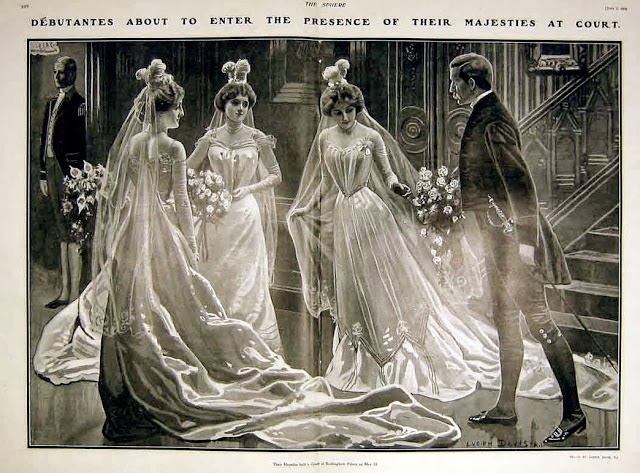Australian Etiquette for Debutantes of the 19th Century, 20th Century and Now
 |
| Debutante Agnes Melanie Dickson, circa 1890. By the end of the 19th century, the main occasions at which Court dresses were worn were those at which debutantes were presented to the Queen. |
 |
| Debutantes, Circa 1930s, at the Roman Catholic Ball in Mareeba, a town on the Atherton Tableland in Far North Queensland, Australia |
∞∞∞∞∞∞∞∞∞∞∞∞∞∞∞∞∞∞∞∞∞∞∞∞∞∞∞∞
|
In the twentieth century (especially following the First World War), occasions for full Court dress diminished. It was still required wear for ladies attending the 1937 Coronation (albeit without trains and veils - and Peeresses were expected to wear tiaras rather than feathers). The following video, "Debutantes" was produced by the BBC is well worth the watch. This is a fascinating look at the last Debutante Ball, prior to WWII.
It includes the Duke and Duchess of Devonshire, the Duke of Wellington and Lady Macmillan, among many others, as they recall the debutante season of 1939. They reveal how the upper classes' diaries were packed with invitations to luncheon parties, dances and social occasions such as Ascot, Henley and the Chelsea Flower Show, as women desperately sought wealthy husbands, all while Europe was steeling itself in the face of fascist aggression. The upper-class marriage market was in full swing, and here the participants talk vividly about the parties, ballgowns and, of course, broken hearts.
Debutante Etiquette 1940s-1950s
By 1953, ladies attending the Coronation were directed to wear 'evening dresses or afternoon dresses, with a light veiling falling from the back of the head. Tiaras may be worn ... no hats'. Court presentations continued, except during wartime, but they gradually became less opulent. In the post-war 1940s evening Courts were replaced with afternoon presentations (for which afternoon dresses were worn); and with that, the donning of full Court dress ceased to be a rite of passage for young women taking their place in society.Preparation of a Debutante
When debutantes are to be presented, the married lady who undertakes the responsibility of presenting them is called the Matron of Honour. Her duties include those of chaperone until after the presentation, and advising the ball committee regarding such matters as arrangements of the dais and floral decorations. In order that each debutante will know the correct procedure for the evening, their asked to attend tuition classes prior to the ball.
Presentation
Debutantes must be punctual so that all is in readiness before the official party arrive.
When the Matron of Honour makes the presentations, each debutante is expected to make a graceful full courtsey (sic).
This presentation marks the official entry of a young lady into society, therefore she is expected to remain dignified throughout the evening and not indulge in smoking.
 |
| “Lebanese-Australian” Debutantes of 1945 who worked at Lebanese businesses |
Dress
Conventions states that a debutante should wear either white or cream. However, pale pastel shades of pink or blue are sometimes worn. The style of frocks are not elaborate, and jewelry is not considered correct.
The bouquet and flowers worn in the hair are white with perhaps a hint of pink. Gloves are essential, and shoes should be of white satin.
Flowers are generously employed for the decoration of the dais, and the lady who received the debutante and the Matron of Honour, each receive a bouquet.
From "Etiquette: A comprehensive handbook for all occasions, setting out the general procedure and formality expected of a well mannered person. Specially compiled to see the average Australian's way of life and for formal occasions."
Debutantes 1960s-1970s
"On a winter evening in 1968, the then Prime Minister, the Rt Hon John Gorton, made history by dancing with a young Aboriginal girl at the first national Aboriginal debutante ball. The ball was held at the Sydney Town Hall to celebrate the symbolic ‘coming of age’ of Aboriginal Australians in the referendum held a year earlier. Twenty-five debutantes were presented to the Prime Minister, and Mr Gorton chose to dance with one of the young women, Miss Pearl Anderson. The event unsettled the prevailing attitude to racial segregation of the time and coincided with the period when the growth in Commonwealth powers was starting to change the administration of Aboriginal affairs."
 | |
| Prime Minister John Gorton dancing with a young debutante, Pearl Anderson, at the Foundation for Aboriginal Affairs Debutantes Ball, 1968 (Image courtesy of the State Library of New South Wales |
Australian Debutantes of Today
Aboriginal people in Australia have now been celebrating over 60 years of debutantes' balls. In 2011, twelve teenage girls took part in the ceremony in what is been seen as symbolic first step into adulthood.
 |
| Aborigines celebrate debutantes' ball 60th anniversary |
The organisers say it gives the girls an experience they would not have in their own often troubled communities and makes them feel more comfortable with who they are.
Another 2011 Debutante Ball, Australia
Etiquette Enthusiast, Maura J Graber, is the Site Editor for the Etiquipedia©️ Etiquette Encyclopedia


No comments:
Post a Comment
Note: Only a member of this blog may post a comment.